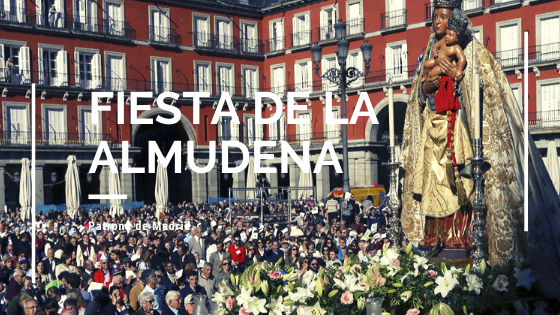Our Lady of Almudena is the patron saint of the city of Madrid and of the Archdiocese of Madrid. It is venerated in the Cathedral of Santa María de la Almudena and its festivity is celebrated on 9 November.
Origin and Legend of La Almudena
In the year 712 the Spanish Goth king Don Rodrigo was defeated in the battle of Guadalete by the Muslim captains Muza and Tariq who established their domination over Toledo and almost the whole Peninsula after a quick conquest.
Madrid at that time was an insignificant village of which not even its old name is known. But the Muslims understood that Madrid was a strategic place and established a great fortress there.
Upon learning of the imminent attack, the Christians decided to save the venerated image of the Virgin Mary, which according to tradition had been brought to this town by a disciple of the Apostle James in the year 38 AD.
For this purpose they hid the image of the Virgin in the wall and left two lights to accompany her.
Almost 400 years the village was under Muslim rule from which it received the name of “Magerit”.
In 1085, Alfonso VI of Castile, “El Bravo”, reconquered Toledo and Madrid.
D. Alfonso wanted to recover the image and organized a “Novenario” so that the Virgin herself enlightened them and directed her steps towards the place where she was.
Thus, on November 9, 1085, the last day of the novena, a procession was held, attended not only by Alfonso VI of Castile, but also by King Don Sancho of Aragon and Navarre, Infante Don Fernando and the famous Cid Campeador, Don Rodrigo Díaz de Vivar. Passing through what is now the Cuesta de la Vega, a piece of wall collapsed by itself and the image of the Virgin appeared with the two lighted candles… which is why the image has a “tanned” face.
From this moment on it became known as Virgen de la Almudena, a name of Arab origin, which had traditionally been considered to come from the word “al-mudy” (almudín), which means “deposit of cereals”; but Arabists and specialised historians agree today that the name comes from the word “al-mudayna”, the old walled military enclosure that occupied the hill where the Cathedral and the Royal Palace of Madrid are now located.
The icon of La Almudena
It is believed that this ancient icon burned in a fire in the Church of Santa Maria during the reign of Philip II.
The icon currently conserved in the cathedral of Madrid is a late Gothic style polychrome gilded wood carving, possibly made between the 15th and 16th centuries. It could be that the head of the Virgin and her hands as well as the head of the Child were those of the image that appeared in 1085.
Attributed to the circle of Sebastián de Almonacid or to Diego Copín de Holanda, both sculptors active in Toledo at the end of the 15th century.
The icon of the Virgin rests on a silver throne with two large candles next to it, also made of silver, in the Baroque style from the year 1640. Framed by a Gothic altarpiece from the 14th century, made by Juan de Borgoña and with later decorations from the 19th century.
The altarpiece, placed at the top, is accessible by means of staircases that border an arch where the funeral chapel of Queen María de las Mercedes de Orleáns, wife of Alfonso XII, a great devotee of the Virgin, is located.
La Almudena, patron saint of Madrid. Worship
From 9 November 1085 is considered by the people as the patron saint of Madrid.
Although officially she was not until Pope Pius X declared her Patroness of Madrid in 1908, marking her feast day on November 9 and Pope Paul VI in 1977 patroness of the Archdiocese of Madrid.
However, there are previous documents such as one from the year 1640 belonging to the archives of the Cathedral in which the Almudena is referred to as “the oldest and only patroness saint of this town.
Its cult had the maximum recognition in 1993 when Pope St. John Paul II inaugurated Its Cathedral.
Court of Honour of Santa María la Real de la Almudena
A few decades earlier, when the Crypt of what is now Almudena Cathedral was inaugurated in 1911, the con of the Patroness Saint was moved there after a few years of pilgrimage through several temples since the demolition in 1868 of the Church of Santa María, built on top of the old mosque.
The Infanta Maria Teresa, sister of King Alfonso XIII, lived in front of the Crypt and visited the Patroness daily so she realized that the Virgin was almost as alone as she was for almost four hundred years in the hollow of the wall of Madrid … Accompanied, then, by two lighted candles.
The Infanta decides that new candles must be lit to accompany the Virgin and for this she creates the Court of Honor on March 25, 1912 in order to veil the Virgin.
Today, the Court is still alive in spite of times of less splendour in which they could hardly fulfill their mission of accompanying the Patroness.
Their mission is primarily to worship Santa María la Real de la Almudena, and to spread their knowledge throughout Madrid. In addition, it carries out a work of social aid to the most needy.
La Almudena Festivity Plans
At 11 a.m. a Mass in honor of the Virgin of the Almudena is celebrated in the Almudena square, between the cathedral and the Royal Palace. At the end of the Mass, the Virgin leaves in procession, a group of 80 bearers of the brotherhood of Jesus the Poor take turns to carry the image of the Virgin on their shoulders from the cathedral to the Plaza Mayor and in reverse (the route crosses the streets Sal, Postas, Esparteros, Mayor and Bailen, to finish in the Plaza de la Almudena).
Translated with www.DeepL.com/Translator (free version)
The Virgin is accompanied by the Ladies of the Court of Honour and the Congregations of the Royal Slavery (founded in 1640) and the Holy Sung Rosary (founded in 1758). Dressed in traditional “mantillas” and capes.
Throughout the day (from 9 a.m. to 8 p.m.) you can see the solidarity floral offering of schools in the Plaza de la Almudena. Also during the day before and after. And a special offering on the afternoon of the 9th reserved for all women called “Almudenas”.
Like all our festivities, it is typical to celebrate them with a sweet: in this case with “Corona de la Almudena” which can be found in many “pastelerías”.
If you are planning to move to Madrid soon, you’ll find all the relevant information in The secret of relocating to Madrid. If, in addition, you need help with the organization or even if you prefer that we accompany you, check out our services.
In the meantime, you can receive regular information by filling out this questionnaire. And if you find it useful, we thank you for sharing it.



